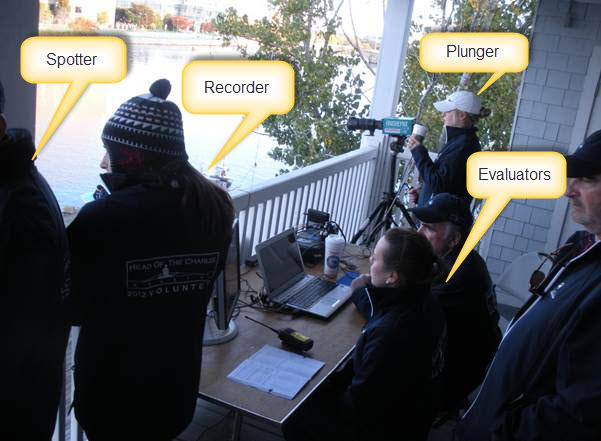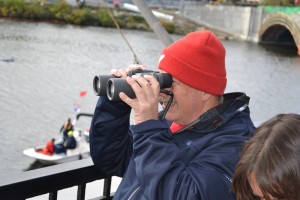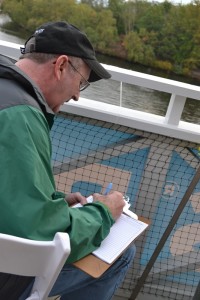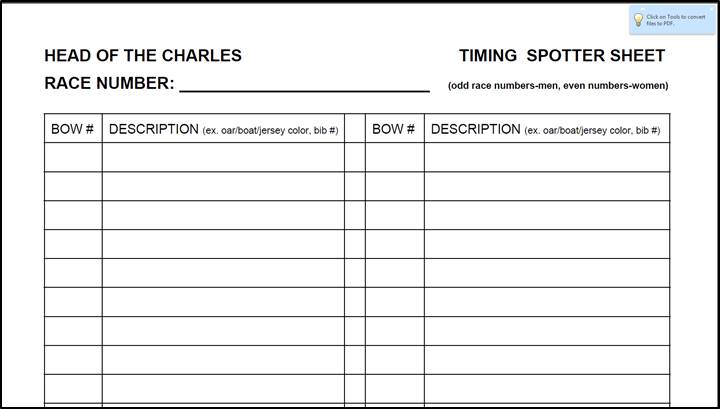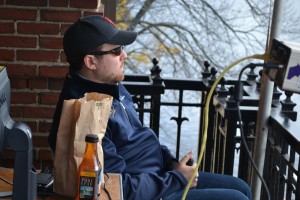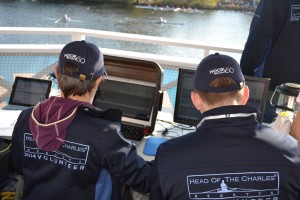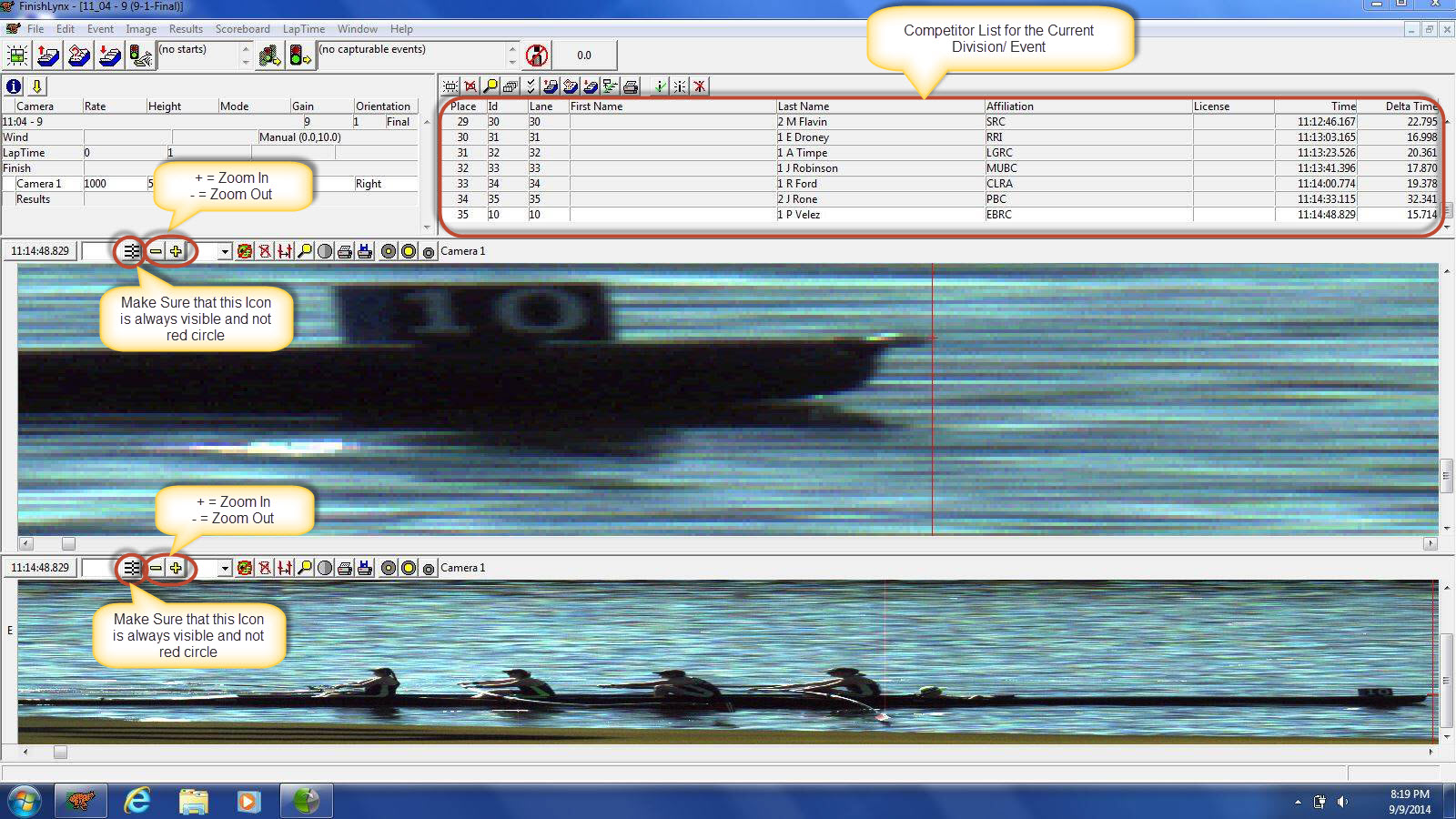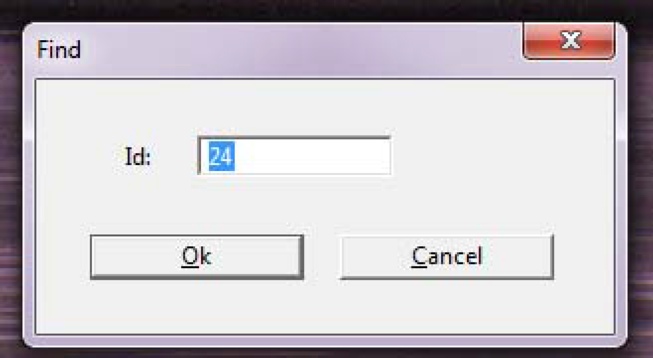Volunteer Quick Study Guide – Fall 2016
1.Volunteer Quick Study Guide Fall 2016
Goals of this Training Guide:
- Outline the Station Roles
- Underline the importance of Computer Timing to the Head of the Charles Regatta
- Describe in detail each of Station Role functions
2.Making it “Real"
- This committee has one of the most important roles of the whole regatta after safety of the competitors
- Our times determine the race times and ultimately medals along with providing qualifying information for future years
- The timing of all boats MUST be captured. Back-up timing is also conducted, but the regatta relies on the computer timing technology for all timing
- Views from the boathouses are beautiful, but you need to focus to ensure we meet our goal – timing for 100% of all competitors
3.Station Roles and Expectations
As a volunteer you will possibly be asked to perform any or all of the 4 Roles at a computer timing station. Please review the training sections for all the Roles. The Station Lead may also do a quick review prior to the beginning of the race and answer questions, so arriving on time for you shift is important. If you feel you are unable or become uncomfortable performing any of the roles, please discuss this with your Station Lead as soon as possible.
4.Station Role - Spotter
- Use the binoculars (as necessary) to spot each boat as it approaches the station
- Verbally tell the Station Recorder what bow number is approaching and describe the crew using:
- Color/Brand of the boat (i.e. black Resolute, yellow Empacher, etc.)
- Color of the uniforms (i.e. blue and green with a star on the back)
- Color of the blades (i.e. blue and green)
- Sometime colors are washed out so location on the water will also work (i.e. near, middle, far)
- If a boat approaches and it is missing it’s bow card then look for the bow number on the back of the first rower (person rowing in the bow of the boat) and when you mention the bow number also state the bow card is missing
- Be as exact as possible if boats are bunched up when they are crossing the timing line. The Station Evaluator will look to you for clarification if they can’t see bow numbers, this can happen often depending on the weather.
- Your job will be particularly important if the water glare during a race is bad and washes out bow numbers (and colors) completely in the picture
- It’s often best to look for the boat number on the rower first as they approach your area of the river. It’s far easier to spot at a distance since it’s larger. You also won’t have to refocus your binoculars quickly if you find that the bow card is missing when they reach you.
- Look ahead, often times you won’t have time to identify the number as well as picking out boat descriptions in the order that they pass, especially when they come through as a group. This happens as boats are overtaking or being overtaken.
- Get descriptions, then put order of crossing as they reach you. The numbers won’t all be in a pretty order, but the information will be accurate which is most important.
- The Spotter needs to tell the Evaluator if boats from the next race are approaching the station, even if all the boats from the current race have not yet crossed.
5.Station Role - Recorder
- Record the information verbally called out by the Station Spotter
- Note: It is critical to log an accurate order of boats. The cameras’ images can be negatively effected by lighting (low in the mornings and glare throughout the day) and weather. This written record is used as back up to assist the evaluator when the camera images are not clear enough to positively identify a boat. While this may only happen to a minority of the images throughout the day it is not an uncommon occurrence.
- This includes writing down;
- Order of passing
- Bow #
- Description of the boat and/or crew (color of the boat, uniforms, blades, etc.)
- Where on the water (near, middle, far) when boats are grouped together
- All sheets should be kept in order on the clipboard and race number put at the top of the sheet
- Put Station Name at the top of the sheet
Recorder Sheet
- These sheets are very important. They are the written record of the race and can be used when there is a dependency or challenge in race results.
- They are also used to assist the Evaluator when they can not make out a bow number or they fall behind.
- Note: It may be helpful to have another volunteer to act a go between, to assist in communication between the Recorder and Evaluator.
6.Station Role - Plunger
- START and FINISH have two plunger operators and the SPLITs have one plunger operator
- All cameras MUST capture all the boats
- Locate camera timing line out in front of the station (ask the Station Lead for this information)
- Locate 2 reference points on other shore for 2 boat lengths before and 2 boat lengths after that line (see picture below)
- Hold switch/plunger down from 2 boat lengths before the line to 2 boat lengths after the line
- If boats are close together do not release switch/plunger
- Boat reference point is the bow ball and bow number on front
- Switch/plunger down = taking video/snapshots
- Never forget to test capture before the race
- If you’re plunging and something should happen on the river (boat collision, boat sink, etc.), do not let that distract you.
- Boats will still be coming and they need times, this is the only job in computer timing that can not be fixed.
- If you are on a task, do it. Let someone else worry about the river excitement.
- Don’t be nervous, don’t panic, but be accurate!
7.Station Role -Evaluator
- The name of the evaluation software is Finish Lynx. With the cameras it records the images of the race and the Evaluator uses it to mark/assign times to boats. The HearNow software checks, manages and publishes the results.
- Below is a picture of the main Finish Lynx evaluation screen:
- As called out in the picture above the Plunger Icon should NEVER have a red circle around it with a red line though the center. Notify the Station Lead and check the connections for the plunger.
- Additionally use the scroll bars at the bottom of the picture windows the scroll though the images of the captured boats in a race.
- You can use the + or – icons to increase or decrease the size of the image being displayed in either panel.
- It is easiest to have the split screen and use the lower panel, zoomed out, to find the next boat to be evaluated. Then click slightly to the left and above the bow ball to bring that into focus in the upper panel, zoomed in.
8.Station Role – Evaluator: Capturing
- In order to perform a “capture” for a boat, please perform the following steps:
- Zoom in on boat bow ball as close as possible
- Clicking on captured image will also zoom in and center image
- Important to become quick and accurate at this task to save time
- Place red crosshair at tip of bow ball
- Record event and boat number in blinking curser box (ex. 1-29) An alternate method is to right click or shift, click to select the boat number from a drop down list
- Zoom all the way out between close proximity teams
- Select the boat number from the drop down list or type it in
- Zoom in on boat bow ball as close as possible
- Data is collected and transferred to the central servers automatically by the HereNow software (CTL+Z is no longer needed)
- ‘Real-time’ results means that we are moving our data up to the server continuously.
- Don’t be nervous, don’t panic, but be accurate
9.Station Role – Evaluator: Between Events
Between every event:
Note: it is most important to Mark boats accurately in a timely manner just after they pass the station. If you have some time between individual events.
- Confirm previous times have been updated in the HearNow system
- Update Did Not Starts (DNS) and Did Not Finish (DNF) boats as necessary
- Check check the HereNow for red colored times to identify discrepancies between times recorded on both systems (Start and Finish) or between the computer systems and the iPad (Splits)
- Camera test capture with Plunger/Switch
- Verify test capture appears as water
- Notify the Station Lead immediately if picture is washing out from too much sun or getting too dark from lack of light.
10.Station Role – Evaluator: During race Missing Boats
- Bow ball marking on the computer needs to happen quickly! If you’re not able to mark them fast enough for some events, your station lead may need to step in to assist. Listen to your station lead if you’re falling behind in the bow ball marking
- Continue to evaluate until all boats in race have been evaluated, IF there are missing unevaluated boats:
- Let your Station Lead know, we work as a team and it is important to communicate, they will help resolve the issue.
- Verify with the Recorder that they have or have not all passed, there may have been boats that did not start or dropped out, extreamly slow, etc…
- IF THERE IS TIME, back up though captured images to try and find the missing boat
MISSING Boats:
NOTE: Only use this procedure if you have the time. If boats are passing it is MOST important to ensure the correct capture and marking of the race. Make a note of the event and boat number then come back to this as soon as you have time. Each Station will need to have all boats accounted for before the end of the day and you can go home.
Challenge: You have realized that you missed a boat when evaluating results. In this example we will be looking for bow number 8. First you check with the person recording the finish order to find out which boats the missing boat is between. We find that bow 8 is between bow 24 and bow 14 (boat order can vary, do not expect the boats to pass in Bow Number order except at the Start and even there things can get out of order though much less frequently). You could scroll through the image to try and find the missing boat, but there is a feature built into FinishLynx that makes it much faster to locate the missing boat.
Locate the Magnifying Glass in the menu bar above the entries
When you select this button a new window will pop up in the middle of the screen as seen below:
Enter the bow number of one of the bows that you know the missing boat is between. In this example I will enter 24 and select OK.
This will then locate the front of the bow 24 on the screen. Scroll the screen to locate the missed boat. In this example bow 8 is very close to bow 24. Note that there is no red line on bow 8. This indicates that bow 8 does not have a time recorded then evaluate normally.
If there is a red line then the boat was most likely marked incorrectly
11.Thank You for Volunteering!
For any questions about this information, please reach out to the Computer Timing Committee at timing@hocr.org or bring any questions to your Station Lead race weekend. Computer Timing Volunteer shifts are all day and you will be expected to stay all day unless previously arranged with the Timing Committee.
